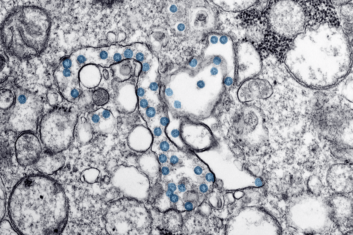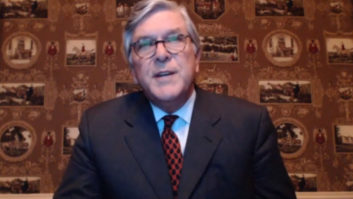
Here’s a sampling of developments in the U.S. radio industry concerning the novel coronavirus situation, as of Tuesday, March 17.
Federal Communications Commission Chairman Ajit Pai held a conference call with broadcasters and their trade associations to thank them for helping to educate people about the pandemic. “Going forward, I urged them to air public service announcements featuring prominent entertainment and sports personalities, and local news anchors asking Americans to practice the social distancing that is needed to combat this pandemic.” He thanked the NAB for its Coronavirus Response Toolkit for stations, asked broadcasters to work with cable and satellite operators to avoid service disruptions and acknowledged that the pandemic would likely have an impact on the post-incentive auction repack.
GatesAir CEO Bruce Swail sent a letter Monday to customers and partners. “At the present GatesAir is open and operational at all our campuses, most notably including our Brescia Italy site. Where practical we have many employees working remotely using our many remote worker IT capabilities.” The company is following CDC guidelines for restricted travel, as well as hygiene and safety practices at its campuses.
“Our supply chain has secured sufficient inbound materials to support production through the first half of 2020 thus, barring new staffing restrictions on site, we do not foresee any production slippages in that timeframe,” Swail wrote. “The supply chain issues (raw components) originating out of Asia appear to be on the mend and given our already assured material pipeline we are hopeful to not see interruptions in second half of 2020 either.” He said service teams and contracted installer crews are working per existing plans but that schedules may be affected by “travel restrictions, living accommodations, or station support staff availability to complete the installations.”
Manufacturer Inovonics said it is open for business by operating a skeleton crew at the factory and implementing precautionary measures. It said it has an ample supply of inventory. “It is during difficult times like these when people turn to radio for critical information. Which is all the more reason to keep calm, use best practices and stay on the air. The world needs you.”
ABC Audio is offering a COVID-19 digital text feed to any interested radio stations. “Stations — regardless of their current affiliation with ABC Audio or ABC News Radio — can utilize the new RSS feed to auto-populate their websites and apps with stories related to COVID-19 without a fee.” It also offers stations the use of video and social media content from the ABC Power Portal at no cost. This is through the end of April. Email [email protected] or [email protected].
Law firm Pillsbury will hold a webinar Thursday on various business and security implications. The content is for businesses generally; the firm’s practice includes broadcasters. “Protecting Your People & Your Business During a Global Pandemic.”
Westwood One, network radio partner of the NCAA, said it will rerun 15 “Great Games in NCAA Tournament History” in partial lieu of this year’s March Madness coverage. The three-week run of games will begin Thursday with the 1979 NCAA championship game between Michigan State and Indiana State, which starred Magic Johnson and Larry Bird. Each game will feature play-by-play as it aired originally, but edited down to minimize interruptions.
The broadcaster also published answers to common questions it says are being asked by ad agencies and advertisers about the habits of people who are working from home. Read it here.
The Vermont Association of Broadcasters has partnered with Vermont’s Department of Emergency Management to take precautionary measures. “In the very unlikely event that an EAS message is issued for quarantine or curfew in Vermont, the system code most likely to activate that event is SPW (shelter in place). Please make sure your engineers have your EAS boxes set up to recognize this code and potentially auto-forward messages,” VAB told members.
The association also encouraged stations to develop a physical contingency plan in case of having to close down facilities, and to stay in touch with third-party contacts at tower sites to make sure of access if public land closures come.
Comrex Technical Director Tom Hartnett said, “The move to virtualize live radio had already started and a lot of that gear is already in place, or can be repurposed.” He said many radio professionals clearly were thinking ahead. “The demand for our remote broadcast codecs has certainly ramped in recent weeks, and my sense is stations have created reasoned policies about cleaning gear, using disposable products like microphone shields, and allowing staff to work from home.”
How has Comrex responded in its own operations? “There have already been manufacturing challenges this year due to Chinese tariffs and other factors. And we got some long-awaited sizable orders through just before the virus hit. But so far, our team has managed to keep production rolling. This is due to some really good forecasting combined with some luck. We’ve prioritized manufacturing and testing of codec products that will be in highest demand through the crisis.” If there is any silver lining, Hartnett added, “I think we’ll find the need to centralize operations is much less than we thought, and we’ll continue creating more live content from home after the virus wanes.”
Equipment manufacturer Progressive Concepts reports a “huge increase” in sales of its Part 15 Stereo FM transmitters and the RODECaster Pro mixer for broadcasting in parking lots used for coronavirus testing. President Eric Hoppe noted that this is a license-free solution to get information to occupants of vehicles as they enter the parking lots where coronavirus testing sites are located.
Consultant and radio app developer Fred Jacobs wrote on his blog that consumers who don’t drive to work will spend less time in their cars. “Radio’s #1 listening environment — driving in the car with the radio on — is going to take a hit.” Jacobs recommends that stations that haven’t opened up their apps lately give them a test drive. “Whatever developer you bought it from ought to be able to make the necessary modifications to get it running smoothly again. If you’ve hesitated to promote your app because ‘you can’t make any money from streaming,’ you might want to rethink that strategy right about now. For a growing number of listeners, your stream — and specifically, your app — may be the only way they can hear you. … If you want your content to be heard in 2020, you’d better have the best mobile interface you can afford.
Wayne Pecena, president of the Society of Broadcast Engineers, says broadcasters are aggressively seeking to minimize or eliminate human presence in studios in terms of staff and individuals from the community. “In my case as a university licensee, it has meant cancellation of local studio production activities and as many staff members as possible working from home. Whereas the university is ‘open,’ classes have been suspended and turning to online resources to finish the semester.”
Pecena expects stations will ramp up remote “home” studios for local programming or even re-purposing “sports remote gear” as athletic events are being cancelled. “Stations that have adopted automation are likely better prepared for remote operation.” He cautioned that stations keep cybersecurity in mind. “For some who are quickly ramping up ‘work at home’ or remote access capability, do not overlook cybersecurity precautions. Unfortunately, cyber criminals likely see ‘opportunity’ as the rush to turn-up remote access capabilities might leave cybersecurity precautions minimize or forgo entirely for later.
The Radio TV Digital News Association published guidelines on keeping newsrooms clean. Among them: Don’t require field crews to report to the newsroom. Don’t use mics that touch interviewees. Use online interview tools as much as possible. Skip the handshakes.
The Sun Broadcast Group broadcast network said it is offering free programming to any radio stations that need to fill airtime due to the recent pandemic. “If stations are in need, they can reach out to SBG and receive any programming in their lineup that is available in their market for as long as needed, free of charge. There are no strings attached and no contracts needed.”
Beasley Media Group moved fast to deal with business closures with a campaign called “Operation Gift Card: New England in the Greater Boston area. Its stations are inviting area restaurants, free of charge, to submit links to feature their gift card pages on Beasley Media Group Boston websites.
The Telos Alliance published cleaning and disinfecting instructions for working with consoles, microphones and other common surfaces. Among them: “Avoid equipment-spraying disasters by training people in-person about the proper use of cleaners and disinfectants around broadcast gear.”
When getting set up to work at home, Telos Senior Solutions Consultant Kirk Harnack said that in the rush to get remote talent on-air, stations may be tempted to bypass best-practice IT security measures. “This can open the door to hackers seeking specifically to leverage this opportunity. One rule of thumb for broadcast and IT engineers is this: If you have to forward a router port to a general purpose PC, you’s best re-think your approach to remote access. Perhaps the only router ports that should be open to the internet are those related to establishing client VPN connections. Require remote users to instantiate a VPN connection in order to access the fire-walled network. And the network to which they have access should be restricted to only those devices they’ll need to control,” Harnack said.
As far as best practices, Harnack said, clean your equipment, especially high-touch areas like fader knobs, speaker and headphone controls, mics, touchscreens and personal phones. Have employees bring and use their own headphones and mic muffs; get blue nitrile gloves for on-air staff. “We’ll get through this,” he said. “Indeed, now is a great time for radio stations to reconnect with their audiences. Many people are at home —on social media. This could be an ideal time for broadcasters to promote their shows, to re-stablish the companionship that comes through the human voice. This is a great time to demonstrate what radio can be to our listeners.”












